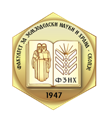THE EVALUATION OF SOME HEAVY METALS IN COMMONLY WHEAT BREAD WITH THEIR DAILY INTAKE
Keywords:
Bread analysis, Bread composition, Heavy metals, daily intakeAbstract
Bread is a main staple food and the vital diet that gives approximately 50-90% daily intake of whole calories and proteins. This study was aimed at investigating the content of heavy metals in the different types of wheat bread. A total of 50 various bread categories including Lawasha, Mashini, Samoon, Hawrami and Tiry are provided in bakery stores. The mean concentration of the Cr, Ni, Cd, Pb, As and Co in all the studied bread samples were ranged in (µg kg-1) as follows: 0 - 173.7 for Cr, 117.2 - 313.3 for Ni, 0 - 16.1 for Cd, 0.89 - 357.3 for Pb, 5.60 - 33.9 for As and 3.06 -17.8 for Co. The highest concentration was found for Ni followed by Pb, Cr, As, Cd and Co. The mean daily intake of Cr, Ni, Cd, Pb, As and Co with the consumed bread was 0, 0.5, 4.2, 6.4, 7.4, and 1.6 μg kg-1, respectively. The total daily intake of the studied heavy metals in 300 g bread was determined as follows: Lawasha 1.38, Mashini 1.72, Samoon 1.21, Hawrami 0.88 and Tiry 1.21 μg d-1 bw. The high contents of daily intake of Cr, Ni, Cd, Pb, As, and Co in bread affect people's health. As a result of this study, it can be concluded that bread types are safe from heavy metals. Total daily intake is lower than the permissible limit which is recommended by FAO/WHO. While heavy metals reduce in bread during wheat cultivation and during the bread-making process is still required.



